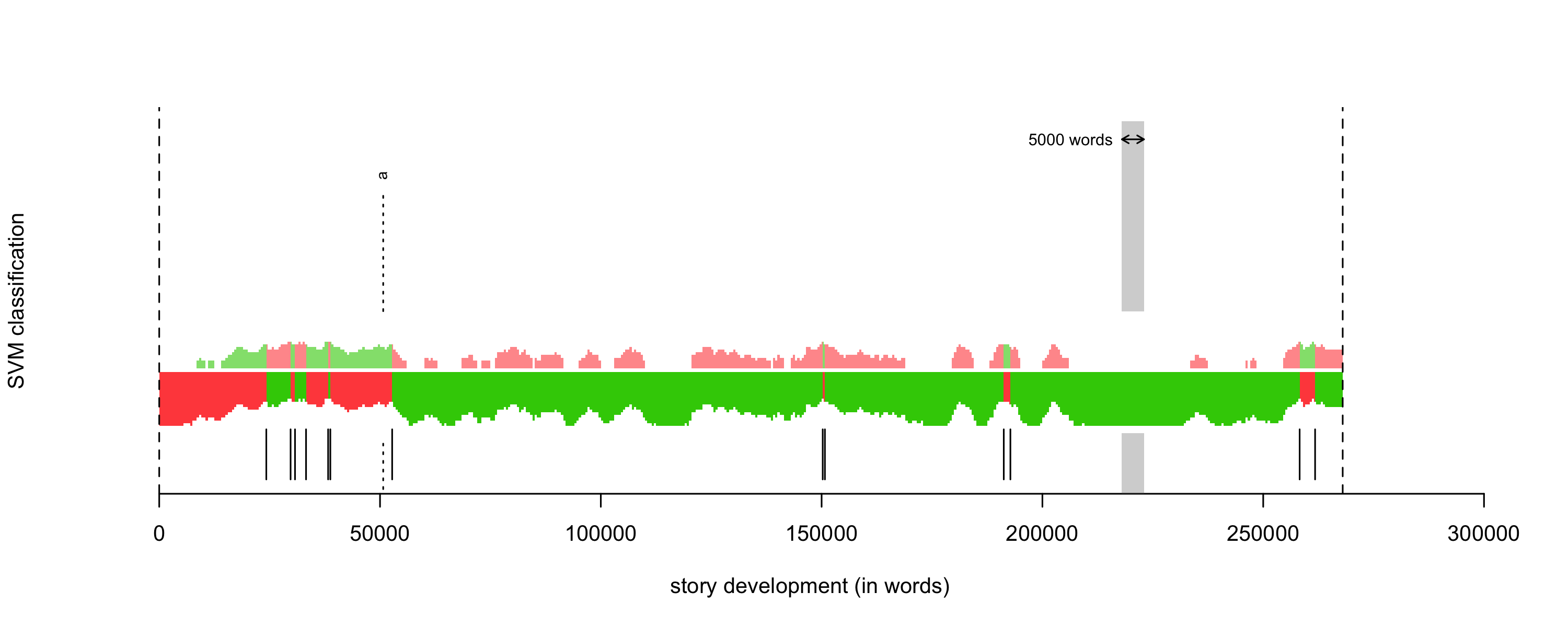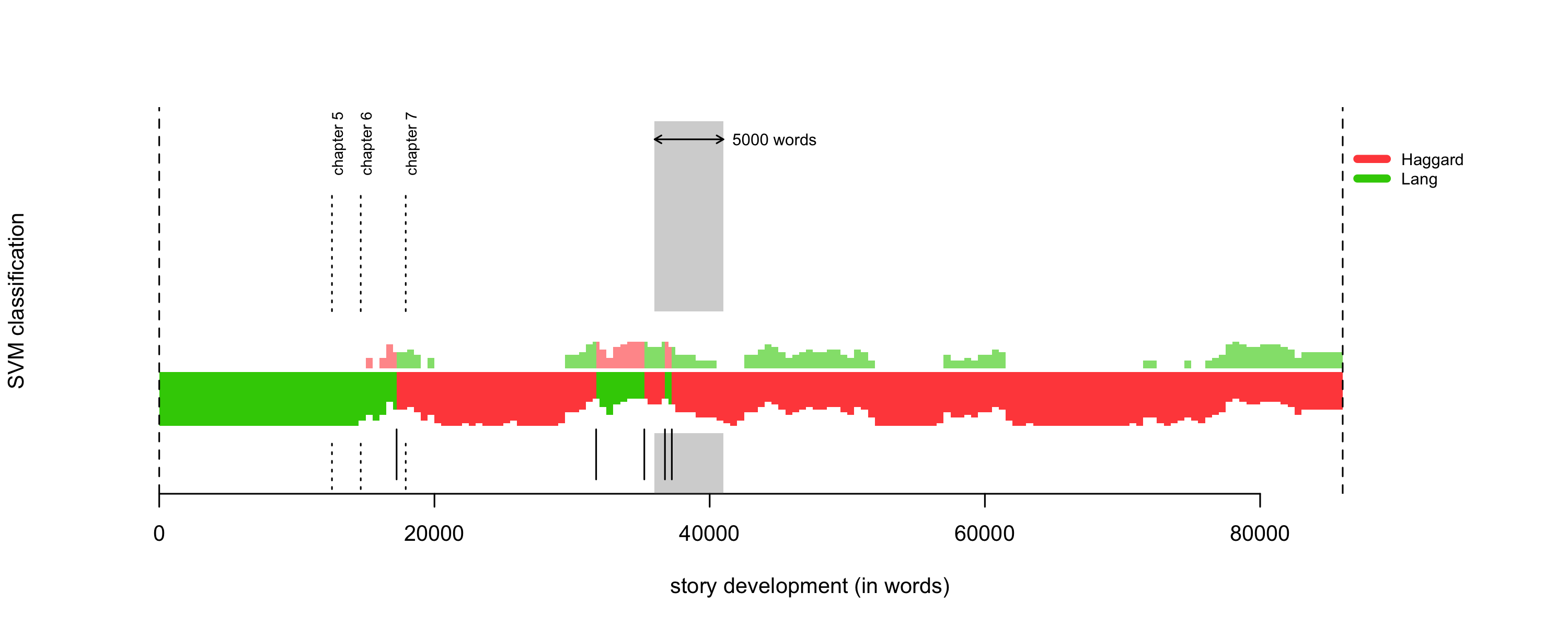Rolling Stylometry
a method of inspecting text fragments

Abstract
This little project started from the following thought experiment: while most state-of-the-art stylometric approaches aim at broadening the scope of the analysis according to the “distant reading” paradigm, do we really understand what a single text is? In other words, the question here was: what about applying a microscope perspective rather than the usual large-scale analysis approach? This thinking led to introducing a new method, supported with compact visualization, that tries to look inside a text, represented as a set of linearly sliced chunks, in order to test their stylistic consistency. Since it is based on the idea of moving slowly through a text to be stylometrized, it has been named Rolling Stylometry.
The following description is but an appetizer. A quick start, supplemented by applicable/reusable snippets of code, can be found in this blog post. For a detailed explanation of the method’s theoretical assumptions, features, and implementation refer to the following paper:
Eder, M. (2016). Rolling stylometry. Digital Scholarship in the Humanities, 31(3): 457-469, [pre-print].
Motivation
Sequential analysis is a very attractive way of studying linear phenomena. The concept of the moving window is particularly important for measuring given elements in their sequential order. It has been introduced to stylometry and extended by van Dalen-Oskam and van Zundert in their study on the medieval Dutch poem titled Roman van Walewein (van Dalen-Oskam and van Zundert, 2007). Other notable approaches to visualize stylistic shifts using moving windows include papers on Middle Dutch rhyme words (Kestemont, 2010), on three disputed English prose texts (Burrows, 2010), and on The Tutor’s Story by Kingsley and Mallet approached with t-tests (Hoover, 2011). Recently, Rolling Delta has been applied to examine collaborative works by Joseph Conrad and Ford Madox Ford (Rybicki et al., 2014).
The Rolling Stylometry method is based on the above approaches. Its general idea is very simple: a text to be analyzed (e.g., an anonymous text to be attributed) is chunked into equal-sized blocks (partially overlapping). Then, instead of attributing the text in its entirety, the goal is to perform an independent similarity test for each chunk, and to inspect the results as a sequence of ordered stylistic signals. Arguably, any classification method can be combined with this procedure. However, so far, the method implementation in stylo includes support vector machines (SVM), nearest shrunken centroids (NSC), and Delta in its classical Burrowsian flavor (Eder, 2015).
An example
The method is designed to detect stylistic takeovers. One example is The World’s Desire, a classic fantasy novel written collaboratively by Henry Rider Haggard and Andrew Lang in 1890. It is a story of the hero Odysseus, who returns home to Ithaca from his journey: however, instead of finding his home at peace, he is involved in several new adventures. The plot of the novel, as well as its mythological background, was set by Lang, while Haggard – the author of several appreciated adventure novels – contributed his imagination and style. It is assumed that Haggard reworked Lang’s drafts and actually wrote most of the novel except the first four chapters, which were written entirely by Lang.

A simple experiment involving a reference corpus of eight novels by Haggard and eight by Lang corroborates the hypothesis. Fig. 2 shows the results of the Rolling Classify technique applied to The World’s Desire using 100 MFWs. You can easily observe a stylistic takeover in the first part of the text. The break point takes place in the middle of the sixth chapter. Also, some sections in the central part of the novel appear to be Lang’s. However, these apparent Lang’s sectors evaporate when a different MFW strata is used for the test.

For 500 MFWs, Haggard’s signal shows up for a short moment in the first chapters of the novel. When 1000 MFWs are taken into consideration (Fig. 3), the distinction between two authorial voices in the sixth chapter is the only takeover that can be observed.
Appications
The method has been successfully applied in a number of studies by the members of the Group. Probably the most spectacular is a short study on Harper Lee that has been featured in the Wall Street Journal, and then evolved into a regular research project. Another example is a study on Elena Ferrante as a “virtual author”, having a different voice from the actual person behind the pseudonym (Eder, 2018).
References
Burrows, J. (2010). Never say always again: Reflections on the numbers game. In McCarty, W. (ed.), Text and Genre in Reconstruction: Effects of Digitalization on Ideas, Behaviors, Products and Institutions. Cambridge: Open Book Publishers, pp. 13–36.
Eder, M. (2015). Through the magnifying glass: rolling stylometry for collaborative authorship. In: Digital Humanities 2015: Book of Abstracts, University of Western Sydney, http://dh2015.org/abstracts, [the poster itself].
Eder, M. (2016). Rolling stylometry. Digital Scholarship in the Humanities, 31(3): 457-469, [pre-print].
Eder, M. (2018). Elena Ferrante: a virtual author. In Tuzzi, A. and Cortelazzo, M. A. (eds), Drawing Elena Ferrante’s Profile. Padova: Padova University Press, pp. 31–45, http://www.padovauniversitypress.it/publications/9788869381300.
Hoover, D. L. (2011). ‘The Tutor’s Story’: A Case Study of Mixed Authorship. In Digital Humanities: Conference Abstracts, Stanford, CA, pp. 149–51.
Kestemont, M. (2010). Velthem et al.: A Stylometric Analysis of the Rhyme Words in the Account of the Battle of the Golden Spurs in the Fifth part of the Spiegel Historiael. Queeste, 17: 1–34.
Rybicki, J., Kestemont, M. and Hoover D. (2014). Collaborative Authorship: Conrad, Ford, and Rolling Delta. Literary and Linguistic Computing, 29(3): 422–31.
van Dalen-Oskam, K. and van Zundert, J. (2007). Delta for Middle Dutch: Author and Copyist Distinction in Walewein. Literary and Linguistic Computing, 22: 345–62.